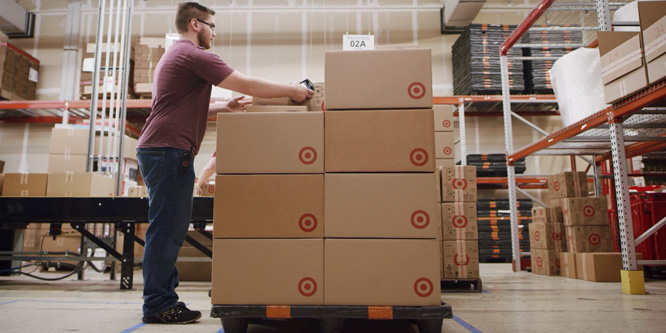
Source: Target
December 9, 2019
How has the retail seasonal hiring playbook changed?
Finding seasonal temps is a tough challenge for retailers in a market with a historically-low unemployment rate, but quickly onboarding them to support a variety of omnichannel tasks represents a whole new learning curve.
Target, for instance, plans to increase seasonal hires by four percent this year to 130,000 after expanding hires by 20 percent for the 2018 holidays, in part to support online selling and BOPIS.
The chain’s in-store seasonal hires focused on fulfilling orders will double this year to support order pickup, drive up and online delivery orders overall. Target now fulfills 80 percent of its online orders from stores. In its third quarter, 80 percent of digital growth was driven by same-day fulfillment options, in-store pickup, Drive-Up and Shipt.
About 8,000 seasonal workers will support Target’s 39 distribution and fulfillment centers, up from 7,500 last year.

A Wall Street Journal article explored how Target is also asking selling floor staff to tackle more chores, including stocking shelves and tracking inventory, under a new staffing system.
Amazon.com has said it plans to hire 200,000 seasonal employees, double the 2018 figure. Amazon attributed the job growth to its expanded logistics infrastructure, including additional warehouses, package sortation hubs and delivery stations. In 2018, Amazon hired seasonal delivery drivers for the first time. The hiring boost comes as Amazon Prime transitions to one-day delivery from two-day.
Among other majors, Macy’s and Kohl’s plan to hire the same amount of seasonal help this year versus last and Walmart, for the fourth straight year, will offer existing employees who want them extra holiday hours. Like Target, however, increased demand for more backroom tasks is expected at these chains, as well. Early figures indicate in-store traffic this holiday is again showing a decline, albeit modest, while online sales and BOPIS are booming.
“We’re hiring less customer-facing people and a lot more people that are doing something else to help the customer, taking care of ‘order online and pick up in-store,’ curbside pickup,” Jan Kniffen, CEO of consultancy J Rogers Kniffen, told CNBC. “That requires a lot more people; they are doing the job the customer used to do.”
- Target’s Hiring More Than 130,000 Team Members for the Holidays — Here’s How to Apply – Target
- The tectonic shift in retail is shaking up how stores hire seasonal workers – CNBC
- Amazon to Double Holiday Hiring to 200,000 – The Associated Press/U.S. News & World Report
- Amazon Doubles Holiday Hiring to 200,000 Temporary Workers – Bloomberg
- Retail Holiday Hiring Reflects Focus On eCommerce, Speed – PYMNTS
- Retailers Revamp Staffing as Fewer Shoppers Visit Stores – The Wall Street Journal
- Holiday hiring wars heat up as retailers fight for scarce talent – NBC News
Discussion Questions
DISCUSSION QUESTIONS: Where do you see the biggest challenges onboarding holiday temps to support omnichannel functions? Which tasks will increasingly require the hiring of more holiday temps in the years ahead?
Poll
BrainTrust
Neil Saunders
Managing Director, GlobalData
Lee Peterson
EVP Thought Leadership, Marketing, WD Partners
Gene Detroyer
Professor, International Business, Guizhou University of Finance & Economics and University of Sanya, China.
Recent Discussions







One of the biggest challenges is finding enough people; unemployment is low and the pool of suitable candidates has been diminished. That’s why retailers are pulling out all the stops to attract holiday workers. Of course, once they’ve got them – often at a higher cost – retailers want to maximize what they get from those employees, which means many more are now expected to multitask across front and backroom operations.
Hiring pickers and stock associates is MUCH different than finding and hiring attentive sales staff; just look at history. To say nothing of having to compete with Amazon AGAIN, but in a different way. And to have to shift so fast is going to be a challenge. The only point on this is that you’d think (operative term) many of the larger retailers would be all over this fact/action. This Black Friday was definitely a tipping point in a number of ways, and this was a big one.
The biggest challenge is demographics. The size of the U.S. labor force for those 65 and under is stagnant and projections through 2024 show no growth. Beyond that the size may actually decline. As the labor force remains level or contracts, more people end up in full time jobs and less are available for seasonal positions.
With literally millions more jobs available currently than people willing to fill them, seasonal hiring will suffer based on the constrained employment pool. What caliber of workers will be available for these jobs?
The bad news for seasonal hiring is the low unemployment rate. The good news is the number of gig workers who may be open to multiple gigs. Retailers should also be looking at seniors to fill those slots – many would be willing to take on something temporarily, and many might be a better fit for customer-facing jobs. With the prospect of record-setting returns on the horizon, shipping and logistics help is likely to be in demand for several weeks post-holiday as well.